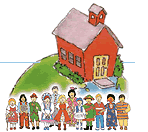This
section directs you to networked projects and
provides several examples to help you choose one.
It also suggests ways to get the most out of your
participation.
Collaborative
Projects
http://www.globalschoolhouse.org
The
Global Schoolhouse™, the "educational pioneer" of
networked-based projects, goes back to 1987. Many
of the original Global Schoolhouse collaborative
projects are featured here, including the
International Schools CyberFair, Field Trips,
GeoGame, and much more.
Projects
Registry
http://www.globalschoolhouse.org/pr/index.html
A
large, searchable database of current projects
from many sources, including teachers around the
world. Moderated to ensure consistently
high-quality projects.
Judi
Harris' Network-Based Educational Activity
Collection
http://communitydisc.wst.esu3.k12.ne.us/HTML/colette/telecom/Activity-Structures.html
This
is a collection of 236 exemplary network-based
educational activities, collected by Judi Harris.
They are available through several different
classifications.
HILITES
- K-12 Collaborative Projects
List
http://www.globalschoolhouse.org/lists/hilites.html
The
Hilites mailing list e-mails project announcements
directly to you, so you don’t need to constantly
check the site. Because this is the only list in
which moderators screen projects for credibility,
we recommend that you begin your mailing list
experience with Hilites. Review the Hilites
archives for hundreds of project ideas.
I*EARN
(The International Education and Resource
Network)
http://www.iearn.org
In
I*EARN projects, students from around the world
collaborate to solve real-world problems and
positively affect resources and people around the
globe. They share their understanding of each
other’s cultures and envision the future. Projects
on the I*EARN site are described in Spanish and
English. These are just four of the many projects
you’ll find at I*EARN.
Child
Labour
Project
http://www.iearn.org/projects/labour.html
Students
research the history of child exploitation and the
child labor used to produce goods sold in their
own communities. They share their thoughts,
feelings, and research findings through essays,
reports, survey results, and artwork. Students
prepare materials for those marching in the 1998
Global March Against Child Labor. Project
participants are asked to write letters to the ILO
and the UNO to speak out against child labor.
Faces
of
War
http://www.iearn.org/projects/facesofwar.html
Classes
interview veterans, refugees, and Holocaust
survivors. They research lifestyles and
environments affected by war and contributions on
the World Wide Web. Project tasks change regularly
and challenge students to design and share medals,
present works on particular themes, and e-mail
government officials about war and war
tactics.
"A
Vision" Literary
Anthology
http://www.iearn.org/projects/avision.html
Teenagers
illustrate their hopes, fears, and concerns
through art and writing (in their own language) to
learn that people of different cultures share
similar thoughts, feelings, and dreams.
First
Peoples
Project
http://www.iearn.org/projects/fp.html
Indigenous
students collaborate with each other and their
non-indigenous peers on research projects, sharing
writing and artwork to learn about one another.
Each month a different student’s artwork and
writing is showcased on the Internet.
Project
Co-NECT
http://www.co-nect.com/Schools/Ops/Projects/
Co-NECT
sponsors projects in which you, your students, and
other classes can participate together. These
projects are interdisciplinary, focusing on
real-world issues to make kids cooperatively think
about and solve problems and use technology to
extend and enrich learning.
NickNack’s
Telecollaborate!
http://home.talkcity.com/academydr/nicknacks/
Many
effective guidelines for creating and managing
your own projects.
The
Grassroots Project
Registry
http://www.schoolnet.ca/grassroots/e/project.centre/index.asp
Canada’s
SchoolNet Web connecting teachers and classrooms
contains many valuable projects and planning
resources.
European
School’s Project
Database
http://www.kc.kuleuven.ac.be/esp/
The
ESP Network is a grassroots network of schools
throughout Europe that conduct a variety of
collaborative projects.
OZ
TeacherNet
http://rite.ed.qut.edu.au/oz-teachernet/
Find
your Travel Buddy partner in this home of the
popular Travel Buddy project. A nice database of
projects in the Australian Curriculum Projects
Registry.
KIDLINK
http://www.kidlink.org
A
global, multilingual, e-mail network for ages
10-15. Adult mentors organize curriculum projects
through KIDPROJ.
Other
Project Examples
This is a small sample of possibilities
available when you begin shopping for
projects.
Passport
to
Knowledge
http://quest.arc.nasa.gov/hst/aboutptk.html
An
ongoing series of middle-school electronic field
trips to scientific frontiers via interactive
television and the Internet. Supported by NASA,
the National Science Foundation, and PBS K-12
Learning Services.
Journey
North
http://www.learner.org/jnorth/
A
free, seasonal project in which North American
students track seasonal changes and
migrations—south in the fall, north in the spring.
Students observe and report animal migrations,
temperature changes, flora (leaves budding or
dropping), fauna (fur, hibernation), etc. When
students pool their data with that of other
students across America, they discover firsthand
the significance of familiar phenomena. Many
related activities and data-sharing stimulate
discussion and exchanges with other
classrooms.
The
Roadkill
Project
http://www.edutel.org/roadkill/
Join
Dr. Splatt to collect and share data about the
diversity and number of animals killed on
highways. This environmental-monitoring project
raises awareness of fragmented wildlife corridors
as it documents an often-overlooked environmental
situation. The Roadkill Project is one of several
at EnviroNet, including BatNet, CoyoteHowl,
SaltTrack, Vernal Pools, and others.
The
Earth Day Groceries Project
2001
http://www.earthdaybags.org/
Students
encourage their local community to "Save the
Earth." They ask for paper bags from grocery-store
managers, decorate the bags with artwork and
environmental messages, then return them to the
grocery store, which uses them to pack groceries
on Earth Day. Teachers send a short e-mail listing
their school, location, and how many bags they
decorated. Available at this Web site are student
artwork from around the world, the project’s
widespread effects, curriculum ideas, and much
more.
Save
the Beaches
2001
http://ednhp.hartford.edu/WWW/Nina/
Students
conduct a cleanup at a local beach. They paint a
picture of their local beach and analyze the
collected waste by submitting a data form. Project
questions help teachers process and interpret
classroom data as students compare their litter
collections with others around the world. Based on
their findings and interpretations, classes
suggest beach cleanup actions. Bonus project ideas
help teachers who want to further enrich this
project’s curriculum content.
